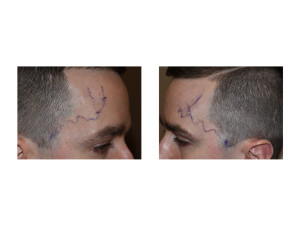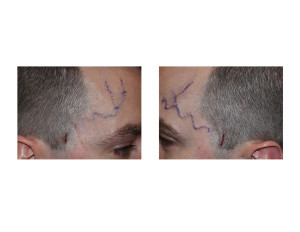Prominent temporal vessels can be a source of aesthetic concern. Looking like worms due to their serpiginous course on the sides of the forehead, they usually have an episodic appearance. When the temperature is warm, the person’s heart rate is elevated or when one bends over, the size of the vessels either become prominent or increasingly so. Prominent temporal vessels largely appear in men and only very rarely in women.
While some think that these prominent temporal vessels are veins, they are in reality arteries. This is easily conformed by feeling the pulsations in them. They are always anterior branches of the superficial temporal artery system. While anatomic drawings usually show them as occurring in one consistent pattern, they present in many variations. The anterior branch may have a low takeoff from the main artery down at the sideburn level or can be much higher in the mid-temporal region.

Due to backflow from various seen and unseen branches off of the anterior branch of the temporal artery, multi-point ligation is usually needed. Placing ligation points close to whether the anterior branch comes off the superficial temporal artery as well as at its most distal point in the forehead is the best technique to prevent recurrent arterial prominence.

Dr. Barry Eppley
Indianapolis, Indiana


